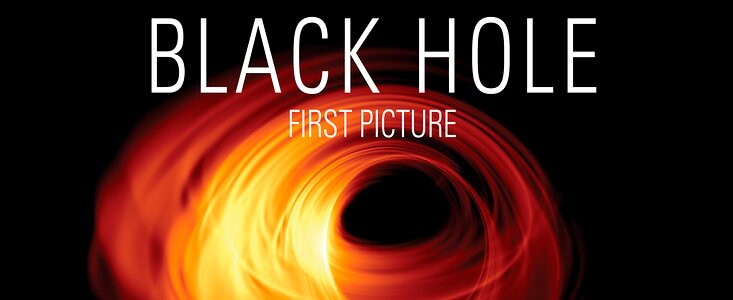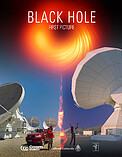es2306 — Organisation Release
Black Hole: First Picture - new planetarium show!
New planetarium show tells the story of the first image ever taken of a black hole
21 August 2023
Appearing on the front pages of newspapers worldwide, the first-ever image of a black hole was a landmark in astronomy. Starting this September, you can delve into the captivating tale of this ground-breaking result through our new full-dome planetarium film Black Hole: First Picture.
Following the story of two young astronomers, you will embark on a journey around the world. From the enchanting Atacama Desert in Chile to the remote expanses of the South Pole, you will travel to the fascinating sites hosting the radio observatories part of the Event Horizon Telescope (EHT). It was this global network of observatories — which includes the Atacama Large Millimeter/submillimeter Array (ALMA) and the Atacama Pathfinder EXperiment (APEX), co-owned and co-operated by ESO — that, through years of observations carried out in unison, achieved the unimaginable: capturing images of the invisible supermassive black holes lurking at the heart of the Messier 87 and Milky Way galaxies.
Produced by the Cosm Studios company Evans & Sutherland, the film weaves together stunning real-world footage captured at seven of the eight EHT telescopes with scientifically accurate visualisations of black holes, achieved through cutting-edge simulations. The result is a breathtaking testament to the tremendous achievements made by these dedicated researchers, leaving a lasting impact on our understanding of the cosmos and sparking curiosity in generations to come.
Curious to find out how astronomers managed to see the unseeable? If so, click this link to book your 5 Euro ticket.
With the ticket, you'll also have access to The Living Universe, our interactive astronomical exhibition where you can further immerse yourself in the mysteries of the cosmos.
More information
The ESO Supernova Planetarium & Visitor Centre
The ESO Supernova Planetarium & Visitor Centre is a cutting-edge astronomy centre for the public and an educational facility, located at the site of the ESO Headquarters in Garching bei München. The centre hosts a digital planetarium with a tilted, 360-degree dome, 14 metres in diameter, and an interactive exhibition, sharing the fascinating world of astronomy and ESO to inspire coming generations to appreciate and understand the Universe around us. All content is provided in English and German. Entrance to the exhibition is free. For planetarium shows, guided tours and other activities, visitors need to book and pay for their tickets online. For more details visit: supernova.eso.org
The ESO Supernova Planetarium & Visitor Centre is a cooperation between the European Southern Observatory (ESO) and the Heidelberg Institute for Theoretical Studies (HITS). The building is a donation from the Klaus Tschira Stiftung (KTS), a German foundation, and ESO runs the facility.
ESO Supernova is proudly supported by: LOR Foundation, Evans & Sutherland and Sky-Skan.
KTS
The Klaus Tschira Stiftung (KTS) was created in 1995 by the physicist and SAP co-founder Klaus Tschira (1940-2015). It is one of Europe’s largest privately funded non-profit foundations. The Foundation promotes the advancement of the natural sciences, mathematics, and computer science, and strives to raise appreciation for these fields. The Foundation’s commitment begins in kindergarten and continues in schools, universities, and research facilities. The Foundation champions new methods of scientific knowledge transfer, and supports both development and intelligible presentation of research findings.
HITS
The Heidelberg Institute for Theoretical Studies (HITS gGmbH) was established in 2010 by the physicist and SAP co-founder Klaus Tschira (1940-2015) and the Klaus Tschira Foundation as a private, non-profit research institute. HITS conducts basic research in the natural sciences, mathematics and computer science, with a focus on processing, structuring, and analysing large amounts of data. The research fields range from molecular biology to astrophysics. The shareholders of HITS are the HITS Stiftung, which is a subsidiary of the Klaus Tschira Foundation, Heidelberg University and the Karlsruhe Institute of Technology (KIT). HITS also cooperates with other universities and research institutes and with industrial partners. The base funding of HITS is provided by the HITS Stiftung with funds received from the Klaus Tschira Foundation. The primary external funding agencies are the Federal Ministry of Education and Research (BMBF), the German Research Foundation (DFG), and the European Union.
ESO
ESO is the foremost intergovernmental astronomy organisation in Europe and the world’s most productive ground-based astronomical observatory by far. It has 16 Member States: Austria, Belgium, the Czech Republic, Denmark, France, Finland, Germany, Ireland, Italy, the Netherlands, Poland, Portugal, Spain, Sweden, Switzerland and the United Kingdom, along with the host state of Chile and with Australia as a Strategic Partner. ESO carries out an ambitious programme focused on the design, construction and operation of powerful ground-based observing facilities enabling astronomers to make important scientific discoveries. ESO also plays a leading role in promoting and organising cooperation in astronomical research. ESO operates three unique world-class observing sites in Chile: La Silla, Paranal and Chajnantor. At Paranal, ESO operates the Very Large Telescope and its world-leading Very Large Telescope Interferometer as well as two survey telescopes, VISTA working in the infrared and the visible-light VLT Survey Telescope. Also at Paranal ESO will host and operate the Cherenkov Telescope Array South, the world’s largest and most sensitive gamma-ray observatory. ESO is also a major partner in two facilities on Chajnantor, APEX and ALMA, the largest astronomical project in existence. And on Cerro Armazones, close to Paranal, ESO is building the 39-metre Extremely Large Telescope, the ELT, which will become “the world’s biggest eye on the sky”.
Links
- ESO Supernova website
- ESO Supernova planetarium programme
- Book your tickets for Black Hole First Picture
- Plan your visit
- Donate to the ESO Supernova
- Subscribe to our newsletter
- Subscribe to our YouTube Channel
- Follow us on Instagram
Contacts
ESO Supernova Planetarium & Besucherzentrum
Garching b. München, Germany
Tel: +49 89 320 06 900
Email: supernova@eso.org
About the Release
| Release No.: | es2306 |


